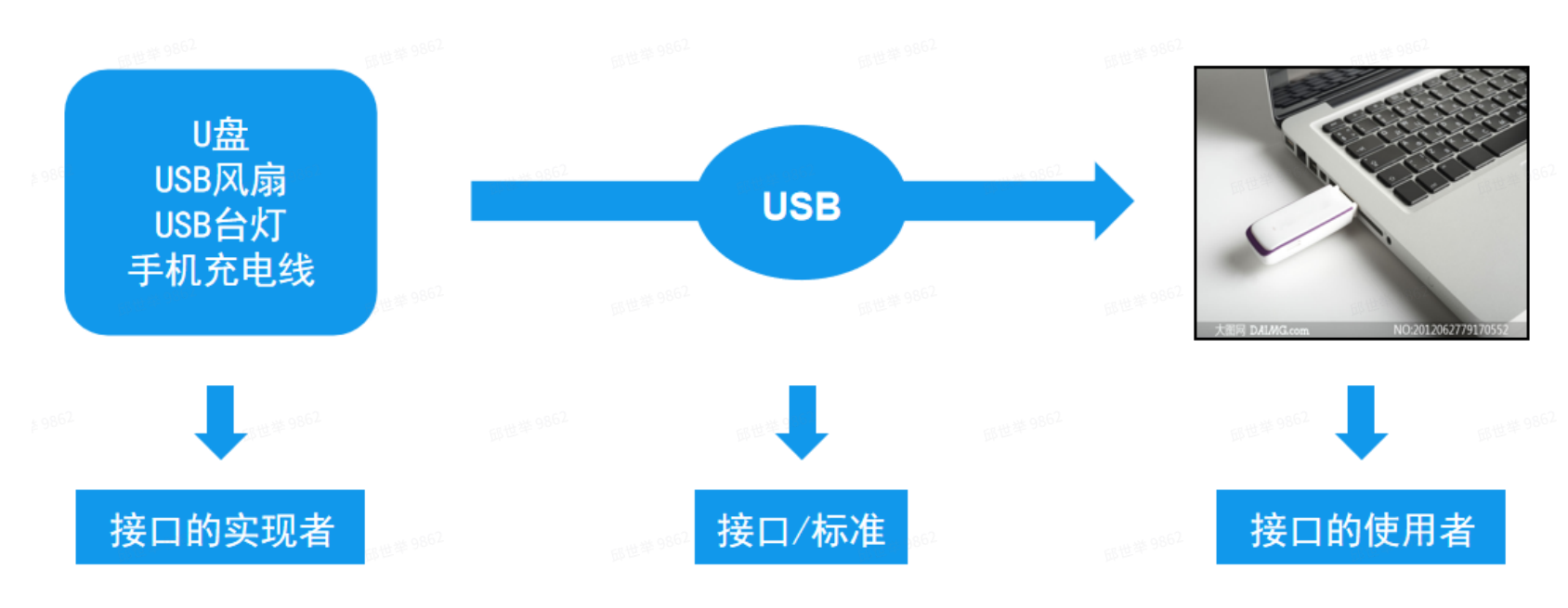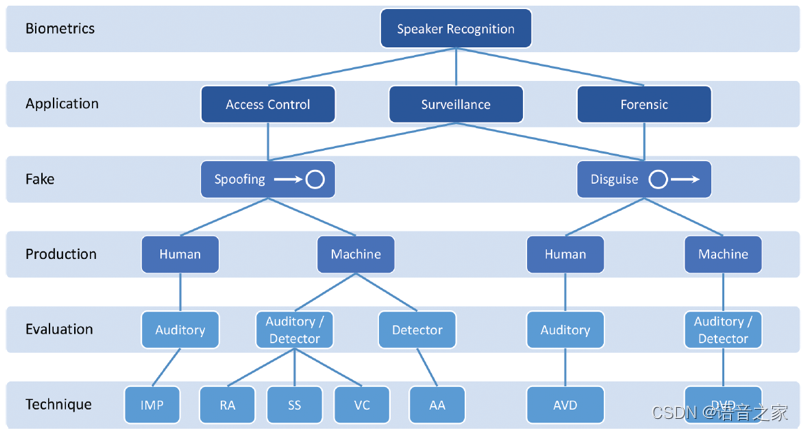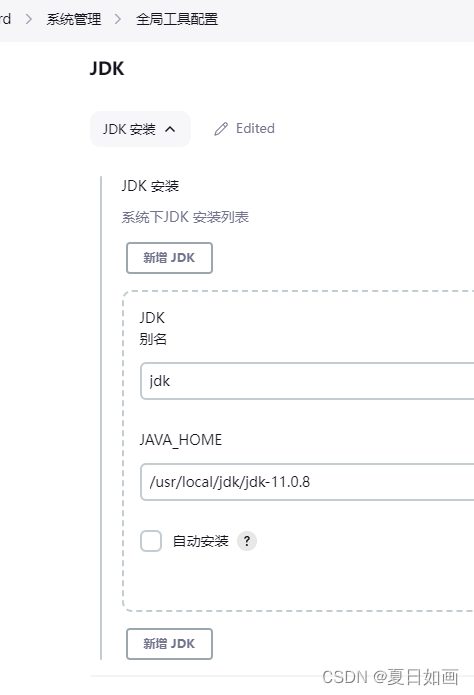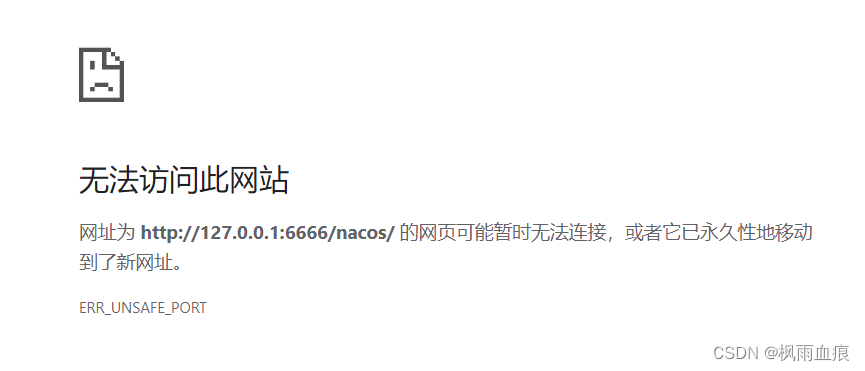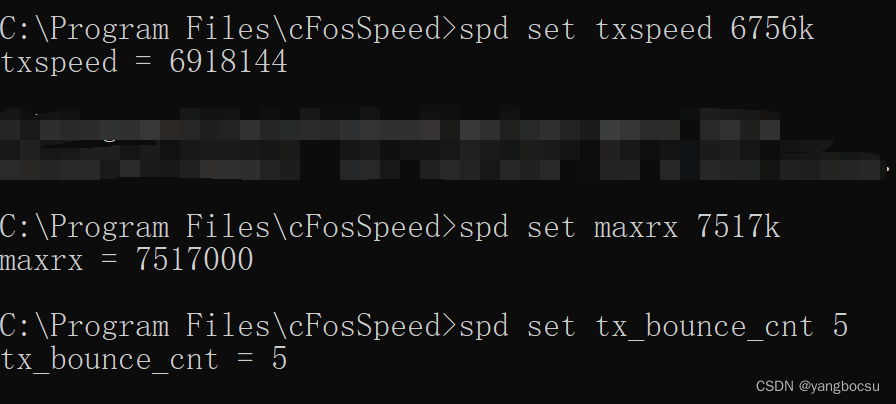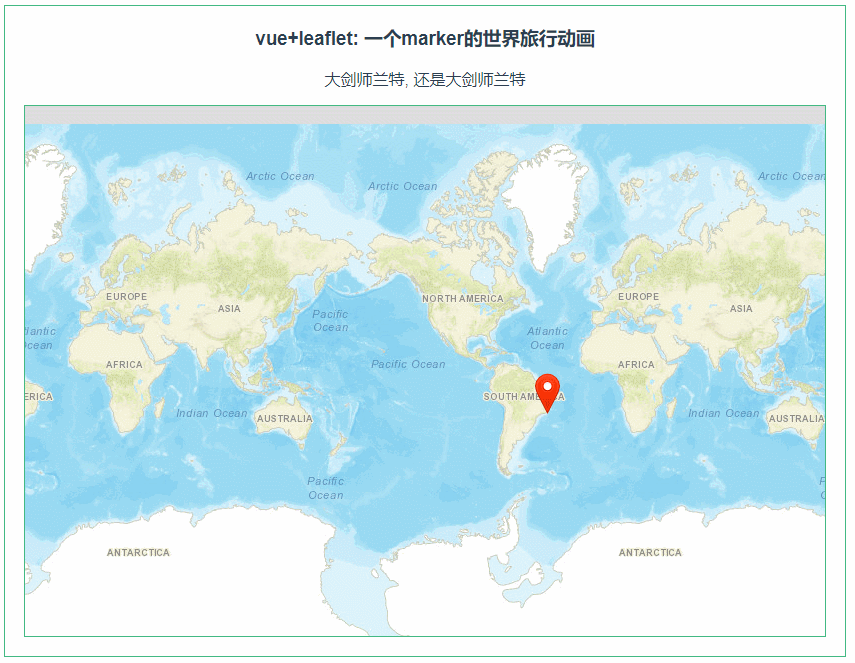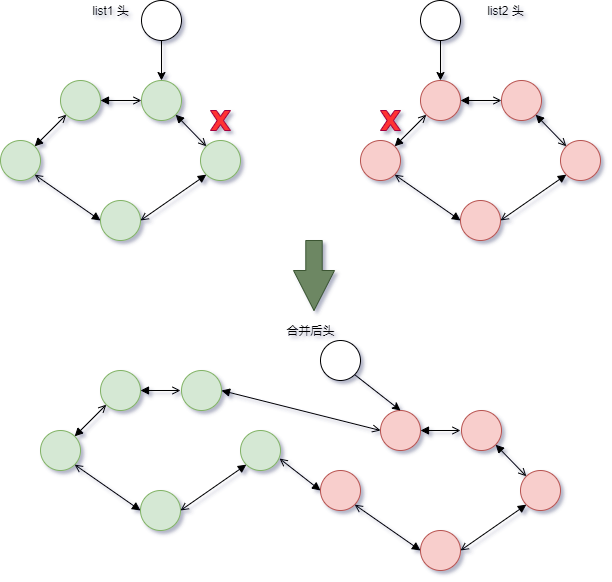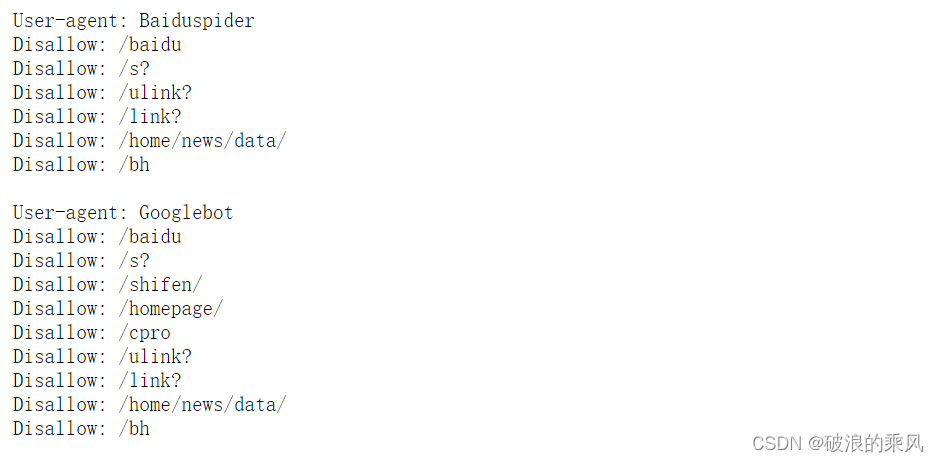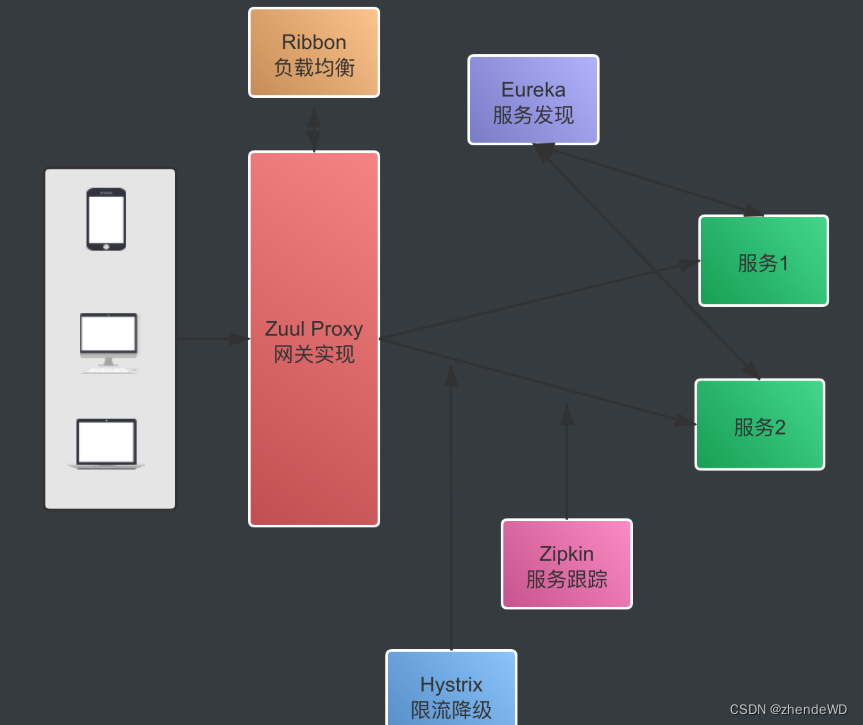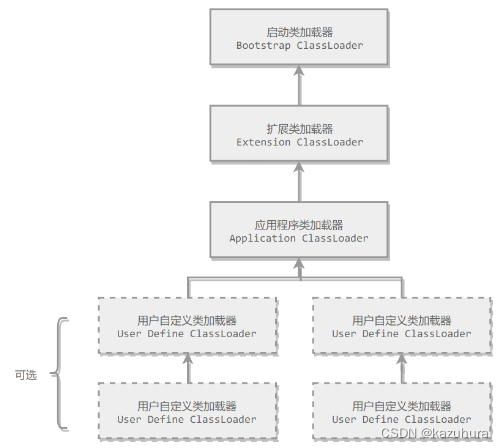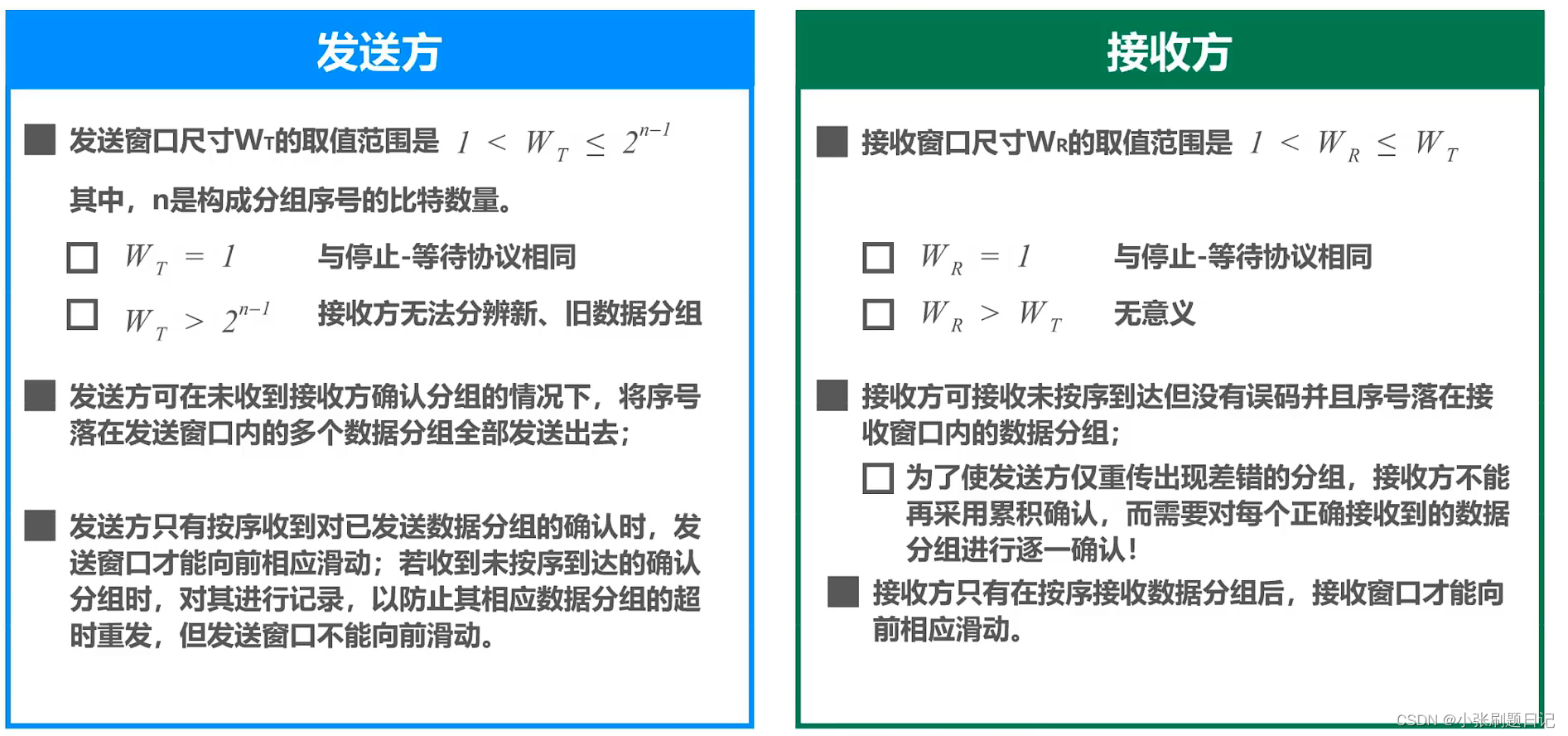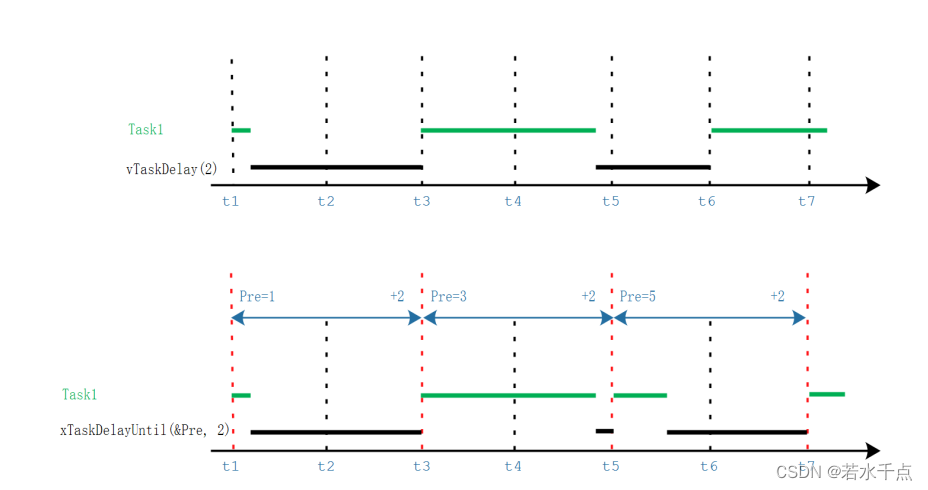案例
- 本文利用natty-all-source 包下的的demo案例 echo来分析下源码,代码如下:
- server 端代码
/**
* Echoes back any received data from a client.
*/
public final class EchoServer {
static final boolean SSL = System.getProperty("ssl") != null;
static final int PORT = Integer.parseInt(System.getProperty("port", "8007"));
public static void main(String[] args) throws Exception {
// Configure SSL.
final SslContext sslCtx;
if (SSL) {
SelfSignedCertificate ssc = new SelfSignedCertificate();
sslCtx = SslContextBuilder.forServer(ssc.certificate(), ssc.privateKey()).build();
} else {
sslCtx = null;
}
// Configure the server.
EventLoopGroup bossGroup = new NioEventLoopGroup(1);
EventLoopGroup workerGroup = new NioEventLoopGroup();
try {
ServerBootstrap b = new ServerBootstrap();
b.group(bossGroup, workerGroup)
.channel(NioServerSocketChannel.class)
.option(ChannelOption.SO_BACKLOG, 100)
.handler(new LoggingHandler(LogLevel.INFO))
.childHandler(new ChannelInitializer<SocketChannel>() {
@Override
public void initChannel(SocketChannel ch) throws Exception {
ChannelPipeline p = ch.pipeline();
if (sslCtx != null) {
p.addLast(sslCtx.newHandler(ch.alloc()));
}
//p.addLast(new LoggingHandler(LogLevel.INFO));
p.addLast(new EchoServerHandler());
}
});
// Start the server.
ChannelFuture f = b.bind(PORT).sync();
// Wait until the server socket is closed.
f.channel().closeFuture().sync();
} finally {
// Shut down all event loops to terminate all threads.
bossGroup.shutdownGracefully();
workerGroup.shutdownGracefully();
}
}
}
/**
* Handler implementation for the echo server.
*/
@Sharable
public class EchoServerHandler extends ChannelInboundHandlerAdapter {
@Override
public void channelRead(ChannelHandlerContext ctx, Object msg) {
System.out.println("server msg:" + msg);
ctx.write(msg);
}
@Override
public void channelReadComplete(ChannelHandlerContext ctx) {
ctx.flush();
}
@Override
public void exceptionCaught(ChannelHandlerContext ctx, Throwable cause) {
// Close the connection when an exception is raised.
cause.printStackTrace();
ctx.close();
}
}
- client 端代码
/**
* Sends one message when a connection is open and echoes back any received
* data to the server. Simply put, the echo client initiates the ping-pong
* traffic between the echo client and server by sending the first message to
* the server.
*/
public final class EchoClient {
static final boolean SSL = System.getProperty("ssl") != null;
static final String HOST = System.getProperty("host", "127.0.0.1");
static final int PORT = Integer.parseInt(System.getProperty("port", "8007"));
static final int SIZE = Integer.parseInt(System.getProperty("size", "256"));
public static void main(String[] args) throws Exception {
// Configure SSL.git
final SslContext sslCtx;
if (SSL) {
sslCtx = SslContextBuilder.forClient()
.trustManager(InsecureTrustManagerFactory.INSTANCE).build();
} else {
sslCtx = null;
}
// Configure the client.
EventLoopGroup group = new NioEventLoopGroup();
try {
Bootstrap b = new Bootstrap();
b.group(group)
.channel(NioSocketChannel.class)
.option(ChannelOption.TCP_NODELAY, true)
.handler(new ChannelInitializer<SocketChannel>() {
@Override
public void initChannel(SocketChannel ch) throws Exception {
ChannelPipeline p = ch.pipeline();
if (sslCtx != null) {
p.addLast(sslCtx.newHandler(ch.alloc(), HOST, PORT));
}
//p.addLast(new LoggingHandler(LogLevel.INFO));
p.addLast(new EchoClientHandler());
}
});
// Start the client.
ChannelFuture f = b.connect(HOST, PORT).sync();
// Wait until the connection is closed.
f.channel().closeFuture().sync();
} finally {
// Shut down the event loop to terminate all threads.
group.shutdownGracefully();
}
}
}
/**
* Handler implementation for the echo client. It initiates the ping-pong
* traffic between the echo client and server by sending the first message to
* the server.
*/
public class EchoClientHandler extends ChannelInboundHandlerAdapter {
private final ByteBuf firstMessage;
/**
* Creates a client-side handler.
*/
public EchoClientHandler() {
firstMessage = Unpooled.buffer(EchoClient.SIZE);
for (int i = 0; i < firstMessage.capacity(); i ++) {
firstMessage.writeByte((byte) i);
}
}
@Override
public void channelActive(ChannelHandlerContext ctx) {
ctx.writeAndFlush(firstMessage);
}
@Override
public void channelRead(ChannelHandlerContext ctx, Object msg) {
System.out.println("msg:" + msg);
ctx.write(msg);
}
@Override
public void channelReadComplete(ChannelHandlerContext ctx) {
ctx.flush();
}
@Override
public void exceptionCaught(ChannelHandlerContext ctx, Throwable cause) {
// Close the connection when an exception is raised.
cause.printStackTrace();
ctx.close();
}
}
- 源码之前,我们先看下代码的流程,我们用一下图来说明Netty的一个基本流程,理解流程后我们可以更好的理解他的实现流程,如下:

源码剖析
- 首先看server启动类,首先创建了关于SSL的配置类,重点分析下创建的两个EventLoopGroup对象:
// Configure the server.
EventLoopGroup bossGroup = new NioEventLoopGroup(1);
EventLoopGroup workerGroup = new NioEventLoopGroup();
- 这两个对象是整个Netty的核心对象,可以说整个Netty的运作都依赖于他们。boosGroup用于接受TCP请求,他会将请求交给workerGroup,workerGroup会获取真正的连接,然后与连接进行通信,比如读写编码解码等操作。
- 线通过NioEventLoopGroup对象的初始化来分析这辆对象内部实现。如下源码
/**
* @see MultithreadEventExecutorGroup#MultithreadEventExecutorGroup(int, Executor, Object...)
*/
protected MultithreadEventLoopGroup(int nThreads, Executor executor, Object... args) {
super(nThreads == 0 ? DEFAULT_EVENT_LOOP_THREADS : nThreads, executor, args);
}
- 在bossGroup中参数1,workerGroup中参数是空,如上当nTHread==0 时候,我们给顶的线程数是DEFAULT。在来看这个默认值是多少:
private static final int DEFAULT_EVENT_LOOP_THREADS;
static {
DEFAULT_EVENT_LOOP_THREADS = Math.max(1, SystemPropertyUtil.getInt(
"io.netty.eventLoopThreads", NettyRuntime.availableProcessors() * 2));
if (logger.isDebugEnabled()) {
logger.debug("-Dio.netty.eventLoopThreads: {}", DEFAULT_EVENT_LOOP_THREADS);
}
}
- 入上源码中,NettyRuntime.availableProcessors() 是获取操作系统中可用的核心数量,那么最终的值是CPU * 2,我们debug验证以是否正确:
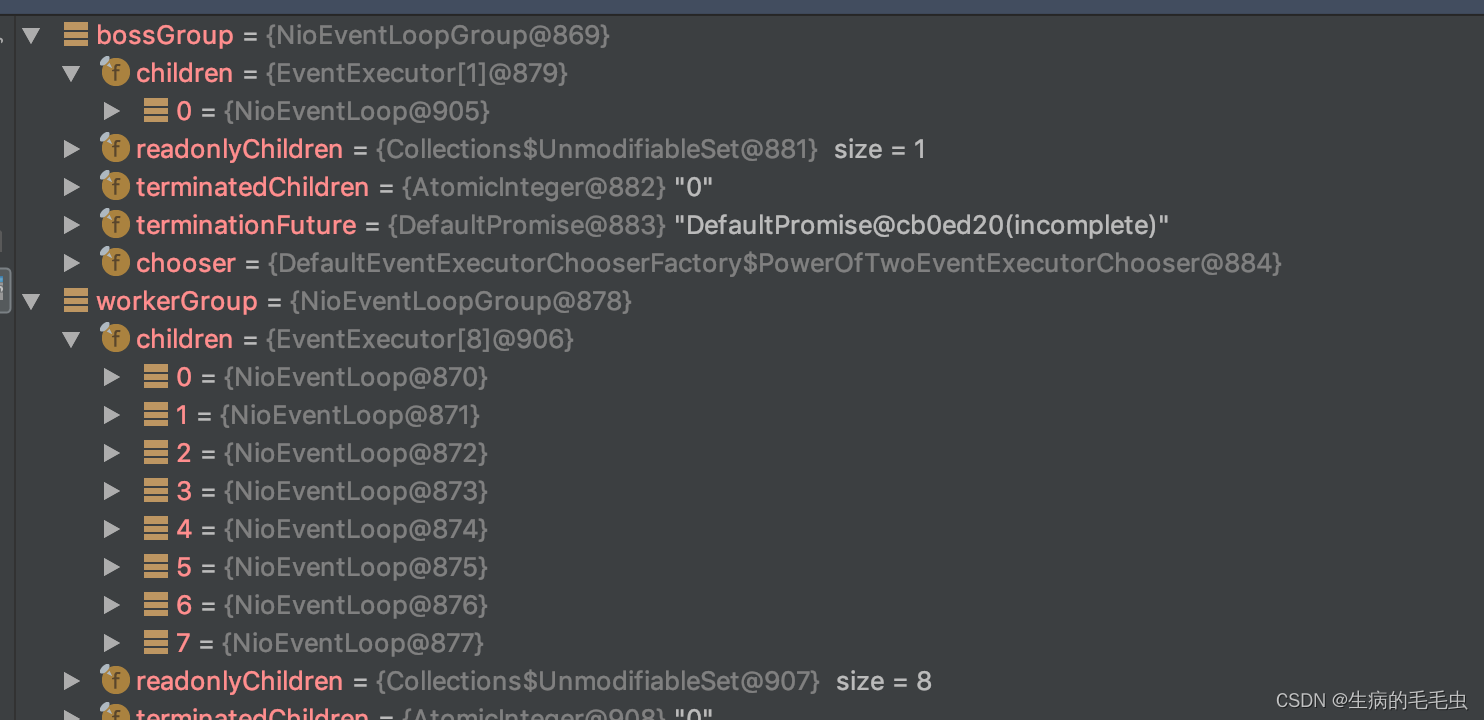
- 如上可看到,因为我们是4核处理器,workerGroup中的线程个数是4*2=8个
/**
* Create a new instance.
*
* @param nThreads the number of threads that will be used by this instance.
* @param executor the Executor to use, or {@code null} if the default should be used.
* @param chooserFactory the {@link EventExecutorChooserFactory} to use.
* @param args arguments which will passed to each {@link #newChild(Executor, Object...)} call
*/
protected MultithreadEventExecutorGroup(int nThreads, Executor executor,
EventExecutorChooserFactory chooserFactory, Object... args) {
if (nThreads <= 0) {
throw new IllegalArgumentException(String.format("nThreads: %d (expected: > 0)", nThreads));
}
if (executor == null) {
executor = new ThreadPerTaskExecutor(newDefaultThreadFactory());
}
children = new EventExecutor[nThreads];
for (int i = 0; i < nThreads; i ++) {
boolean success = false;
try {
//创建new NioEventLoop
children[i] = newChild(executor, args);
success = true;
} catch (Exception e) {
// TODO: Think about if this is a good exception type
throw new IllegalStateException("failed to create a child event loop", e);
} finally {
// 如果创建失败,优雅关闭
if (!success) {
for (int j = 0; j < i; j ++) {
children[j].shutdownGracefully();
}
for (int j = 0; j < i; j ++) {
EventExecutor e = children[j];
try {
while (!e.isTerminated()) {
e.awaitTermination(Integer.MAX_VALUE, TimeUnit.SECONDS);
}
} catch (InterruptedException interrupted) {
// Let the caller handle the interruption.
Thread.currentThread().interrupt();
break;
}
}
}
}
}
chooser = chooserFactory.newChooser(children);
final FutureListener<Object> terminationListener = new FutureListener<Object>() {
@Override
public void operationComplete(Future<Object> future) throws Exception {
if (terminatedChildren.incrementAndGet() == children.length) {
terminationFuture.setSuccess(null);
}
}
};
for (EventExecutor e: children) {
e.terminationFuture().addListener(terminationListener);
}
Set<EventExecutor> childrenSet = new LinkedHashSet<EventExecutor>(children.length);
Collections.addAll(childrenSet, children);
readonlyChildren = Collections.unmodifiableSet(childrenSet);
}
- 最终追踪到源码抽象类MultithreadEventExecutorGroup 的构造方法,MultithreadEventExecutorGroup 才是NioEventLoopGroup真正的初始化,这辆可以看出是一个模板方法,使用了设计模式的模板模式
- 在MultithreadEventExecutorGroup 的父类中AbstractEventExecutorGroup 定义了初始化需要 的一些固定流程,MultithreadEventExecutorGroup方法选择自己需要的方法去实现,这种设计模式就是模板模式
分析MultithreadEventExecutorGroup
- nThread:参数 使用的线程数,默认是core * 2(上面已经分析过)
- executor:执行器:如果传入null,那么会使用Netty默认的ThreadPerTaskExecutor
- chooserFactory :单例 new DefaultEventExecutorChooserFactory
- args:在创建执行器的时候传入的固定参数
children = new EventExecutor[nThreads];
- 如上按线程数量来初始化一个EventExxecutor数组,接着
//创建new NioEventLoop
children[i] = newChild(executor, args);
//newChild源码
@Override
protected EventLoop newChild(Executor executor, Object... args) throws Exception {
EventLoopTaskQueueFactory queueFactory = args.length == 4 ? (EventLoopTaskQueueFactory) args[3] : null;
return new NioEventLoop(this, executor, (SelectorProvider) args[0],
((SelectStrategyFactory) args[1]).newSelectStrategy(), (RejectedExecutionHandler) args[2], queueFactory);
}
-
每个元素的类型给赋值了一个EventLoop,也就是我们的NioEventLoopGroup中是一个NioEventLoop的一个事件循环数组,包含了多个EventLoop,这个可以注册channel,用于在事件循环中去进行选择
-
对于NioEventLoopGroup的初始化总结来说如下:
- 如果executor是null,默认创建一个ThreadPerTaskExecutor,使用Netty默认的线程工厂
- 根据传入的线程数(CPU * 2)创建一个线程池数组
- 循环给数组赋值NioEventLoop。如果异常,则关闭所有单例线程池
- 根据线程选择工厂创建一个线程选择器 chooser = chooserFactory.newChooser(children);
- NioEventLoop 是SingleThreadEventLoop 的子类,也就是单例线程池,接着循环对child中的NioEventLoop添加一个关闭监听器
- 将所有单例线程池NioEventLoop添加到LinkedHashSet 中
ServerBootStrap创建和构造过程
- ServerBootStrap 是一个空构造方法,但是有默认的成员变量,部分代码如下
// The order in which child ChannelOptions are applied is important they may depend on each other for validation
// purposes.
private final Map<ChannelOption<?>, Object> childOptions = new LinkedHashMap<ChannelOption<?>, Object>();
private final Map<AttributeKey<?>, Object> childAttrs = new ConcurrentHashMap<AttributeKey<?>, Object>();
private final ServerBootstrapConfig config = new ServerBootstrapConfig(this);
private volatile EventLoopGroup childGroup;
private volatile ChannelHandler childHandler;
// 空构造
public ServerBootstrap() { }
- 分析demo中ServerBootStrap使用情况
ServerBootstrap b = new ServerBootstrap();
b.group(bossGroup, workerGroup)
.channel(NioServerSocketChannel.class)
.option(ChannelOption.SO_BACKLOG, 100)
.handler(new LoggingHandler(LogLevel.INFO))
.childHandler(new ChannelInitializer<SocketChannel>() {
@Override
public void initChannel(SocketChannel ch) throws Exception {
ChannelPipeline p = ch.pipeline();
if (sslCtx != null) {
p.addLast(sslCtx.newHandler(ch.alloc()));
}
//p.addLast(new LoggingHandler(LogLevel.INFO));
p.addLast(new EchoServerHandler());
}
});
- 链式调用:group方法,将上一步骤中的两个NioEventLoopGroup,bossGroup赋值给parentGroup属性,workerGroup赋值给childGroup属性
- channel方法传入NioServerSocketChannel 的class对象,会根据class对象利用反射机制创建一个NioServerSocketChannel
- option方法传入TCP参数,放在一个LinkHashMap中
- handler方法传入一个LoggingHandler,这个handler只专属于ServerSocketChannel 而不是SocketChannel
- childHandler传入一个handler,这个handler将会在每个客户端连接时候调用。共SockerChannel使用
最终版定端口分析
- 服务端版定端口代码如下:
// Start the server.
ChannelFuture f = b.bind(PORT).sync();
//最终调用
/**
* Create a new {@link Channel} and bind it.
*/
public ChannelFuture bind(SocketAddress localAddress) {
validate();
return doBind(ObjectUtil.checkNotNull(localAddress, "localAddress"));
}
- 如上,线做了部分空判断,核心代码是doBind方法
- doBind代码的核心源码如下,其中最重要的两个方法是InitAndRegister,doBind0
private ChannelFuture doBind(final SocketAddress localAddress) {
final ChannelFuture regFuture = initAndRegister();
final Channel channel = regFuture.channel();
if (regFuture.cause() != null) {
return regFuture;
}
if (regFuture.isDone()) {
// At this point we know that the registration was complete and successful.
ChannelPromise promise = channel.newPromise();
doBind0(regFuture, channel, localAddress, promise);
return promise;
} else {
// Registration future is almost always fulfilled already, but just in case it's not.
final PendingRegistrationPromise promise = new PendingRegistrationPromise(channel);
regFuture.addListener(new ChannelFutureListener() {
@Override
public void operationComplete(ChannelFuture future) throws Exception {
Throwable cause = future.cause();
if (cause != null) {
// Registration on the EventLoop failed so fail the ChannelPromise directly to not cause an
// IllegalStateException once we try to access the EventLoop of the Channel.
promise.setFailure(cause);
} else {
// Registration was successful, so set the correct executor to use.
// See https://github.com/netty/netty/issues/2586
promise.registered();
doBind0(regFuture, channel, localAddress, promise);
}
}
});
return promise;
}
}
分析initAndRegister
- 首先是channel的初始化如下,我们跟代码,发现他只是一个反射机制作的一个对象的获取,
channel = channelFactory.newChannel();
//最终反射获取对象 ReflectiveChannelFactory 中的方法
@Override
public T newChannel() {
try {
return constructor.newInstance();
} catch (Throwable t) {
throw new ChannelException("Unable to create Channel from class " + constructor.getDeclaringClass(), t);
}
}
-
我们线找到 ReflectiveChannelFactory对象中我们传入的class是哪个,这样我们直接去找对应class的构造方法,就可以得到改反射所执行的初始化代码。如下:

-
可以看到,这正是我们在group链式调用中在初始化 ServerBootstrap 中的channel传入的NioServerSocketChannel,接下来就直接到NioServerSocketChannel中的构造方法,如下代码
/**
* Create a new instance, 构造方法
*/
public NioServerSocketChannel() {
this(newSocket(DEFAULT_SELECTOR_PROVIDER));
}
//获取nio中channel
private static ServerSocketChannel newSocket(SelectorProvider provider) {
try {
return provider.openServerSocketChannel();
} catch (IOException e) {
throw new ChannelException(
"Failed to open a server socket.", e);
}
}
//接着 获取到nio中的方法,最终得到的是ServerSocketChannelImpl 是java.nio.channels.Channel 的子类,最终得到的是nio中的channel
public ServerSocketChannel openServerSocketChannel() throws IOException {
return new ServerSocketChannelImpl(this);
}
//构造方法中的this
this(newSocket(DEFAULT_SELECTOR_PROVIDER));
//继续追this中 super ---》 super ---〉 super ---》 得到如下:
protected AbstractChannel(Channel parent) {
this.parent = parent;
id = newId();
unsafe = newUnsafe();
pipeline = newChannelPipeline();
}
-
总结一些channel的初始化如下:
- 通过Nio的SelectorProvider 的 openServerSocketChannel方法得到JDK的channel,目的是得到Netty包装的JDK的channel
- 利用newId() 方法 创建一个唯一的channelId, 利用 newUnsafe();创建了一个NioMessageUnsafe,用于操作消息,利用newChannelPipeline();创建了一个DefaultChannelPipeline,他是个双向链表结构,用于过滤所有进出的消息
- 创建一个NioServerSocketChannelConfig对用于对外展示一些配置
-
Unsafe对象示意图

-
NioServerSocketChannelConfig代码示意图

接着的init(channel);方法
- init方法是用来初始化NioServerSocketChannel,具体追踪代码如
- init方法是AbstractBootStrap累中的一个抽象方法
abstract void init(Channel channel) throws Exception;
- 具体实现是在ServerBootStrap类中,继续根进代码中
- 首先是对channel中的TCP参数赋值,其中的Option参数就是之前我们在ServerBootstrap 链式调用中设置的option,
setChannelOptions(channel, newOptionsArray(), logger);

- 最终是设置了NioServerSocketChannel的TCP属性,如下图
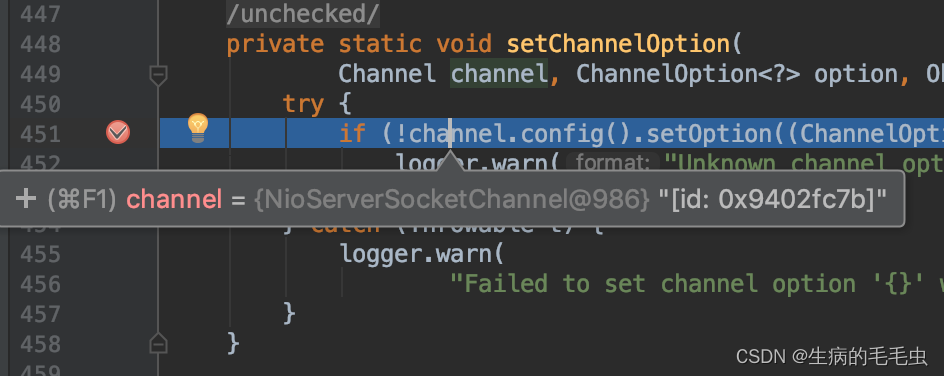
- 接下来也是初始化NioServerSocketChannel中的一些属性,对其中的ChannelPipeline添加ChannelINitializer处理器
- 如下init方法核心addLast方法
@Override
public final ChannelPipeline addLast(EventExecutorGroup group, String name, ChannelHandler handler) {
final AbstractChannelHandlerContext newCtx;
synchronized (this) {
checkMultiplicity(handler);
newCtx = newContext(group, filterName(name, handler), handler);
addLast0(newCtx);
if (!registered) {
newCtx.setAddPending();
callHandlerCallbackLater(newCtx, true);
return this;
}
EventExecutor executor = newCtx.executor();
if (!executor.inEventLoop()) {
callHandlerAddedInEventLoop(newCtx, executor);
return this;
}
}
callHandlerAdded0(newCtx);
return this;
}
- addLast方法在DefaultChannelPipeline 类中,方法是pipeline方法的核心
- 首先 checkMultiplicity 监测handler是否符合标准
- 接着创建一个AbstractChannelHandlerContext newCtx = newContext(group, filterName(name, handler), handler); 对象,此处是ChannelHandlerContext对象的一个子类,而ChannelHandlerContext 是ChannelHandler和 ChannelPipeline之间的关联,每当有ChannelHandler添加到Pipeline中时候,都会创建Context。Context主要功能是管理他所关联的Handler和同一个pipeline中其他Handler的交互
- 接着是 addLast0(newCtx); 方法,如下
private void addLast0(AbstractChannelHandlerContext newCtx) {
AbstractChannelHandlerContext prev = tail.prev;
newCtx.prev = prev;
newCtx.next = tail;
prev.next = newCtx;
tail.prev = newCtx;
}
-
将 利用Handler 生成的context添加到双向队列中,并且是添加到tail节点的前面
-
最后同步或者一步或者晚点一步调用callHandlerAdded0(newCtx);方法
-
总结InitAndRegister方法
- initAndRegister()初始化NioServerSocketChannel 通道并且注册各个Handler,返回一个future
- 通过ServerBootStrap的通道工厂(ReflectiveChannelFactory)反射创建一个NioServerSocketChannel
- init 负责初始化这个NioServerSocketChannel
- 接着 ChannelFuture regFuture = config().group().register(channel); 通过ServerBootStrap的boosGroup 注册NioServerSocketChannel
- 最后繁华一步执行占位符regFuture,此处future是一个ChannelFuture是一个接口,真正的实现类是DefaultChannelPromise
initAndRegister之后的doBind0方法分析
private static void doBind0(
final ChannelFuture regFuture, final Channel channel,
final SocketAddress localAddress, final ChannelPromise promise) {
// This method is invoked before channelRegistered() is triggered. Give user handlers a chance to set up
// the pipeline in its channelRegistered() implementation.
channel.eventLoop().execute(new Runnable() {
@Override
public void run() {
if (regFuture.isSuccess()) {
channel.bind(localAddress, promise).addListener(ChannelFutureListener.CLOSE_ON_FAILURE);
} else {
promise.setFailure(regFuture.cause());
}
}
});
}
//继续更channel.bind方法,因为这里是异步只执行的,debug的时候注意可能跳过去,最终进入到AbstractChannelHandlerContext中的bind方法
@Override
public ChannelFuture bind(final SocketAddress localAddress, final ChannelPromise promise) {
ObjectUtil.checkNotNull(localAddress, "localAddress");
if (isNotValidPromise(promise, false)) {
// cancelled
return promise;
}
final AbstractChannelHandlerContext next = findContextOutbound(MASK_BIND);
EventExecutor executor = next.executor();
if (executor.inEventLoop()) {
next.invokeBind(localAddress, promise);
} else {
safeExecute(executor, new Runnable() {
@Override
public void run() {
next.invokeBind(localAddress, promise);
}
}, promise, null, false);
}
return promise;
}
//继续根 next.invokeBind(localAddress, promise); 方法
((ChannelOutboundHandler) handler()).bind(this, localAddress, promise);
//继续根bind
@Override
public void bind(
ChannelHandlerContext ctx, SocketAddress localAddress, ChannelPromise promise) {
unsafe.bind(localAddress, promise);
}
//继续根bind,到 LoggingHandler 这个handler是我们在ServerBootStrapt中添加的一个handler
public void bind(ChannelHandlerContext ctx, SocketAddress localAddress, ChannelPromise promise) throws Exception {
if (logger.isEnabled(internalLevel)) {
logger.log(internalLevel, format(ctx, "BIND", localAddress));
}
ctx.bind(localAddress, promise);
}
//继续bind方法,此处还会在回到之前的bind方法,不用管,继续往下,到AbstractChannel中bind方法,此处已经获取到 localAddress 对象,并且此处点击步入到方法体实现中去,因为实现类太多了
public final void bind(final SocketAddress localAddress, final ChannelPromise promise) {
......
boolean wasActive = isActive();
try {
doBind(localAddress);
} catch (Throwable t) {
safeSetFailure(promise, t);
closeIfClosed();
return;
}
......
safeSetSuccess(promise);
}
//最后他到了NioServerSocketChannel类中的bind方法
protected void doBind(SocketAddress localAddress) throws Exception {
if (PlatformDependent.javaVersion() >= 7) {
javaChannel().bind(localAddress, config.getBacklog());
} else {
javaChannel().socket().bind(localAddress, config.getBacklog());
}
}
- 如上,最终bind的方法居然是NioServerSocketChannel的dobind,说吗Netty底层就是NIO,最后的端口,ip版的信息由NIO完成
- 接着回到最初的bind方法,还剩最后一个步骤 safeSetSuccess(promise);,这里会高速所有promise任务成功了,器可以执行监听器的方法了,整个启动过程就结束了
- 此时还没结束,我们继续debug,一直下一步执行,他会进入一个无限循环中,如下代码
protected boolean runAllTasks(long timeoutNanos) {
fetchFromScheduledTaskQueue();
Runnable task = pollTask();
if (task == null) {
afterRunningAllTasks();
return false;
}
final long deadline = timeoutNanos > 0 ? ScheduledFutureTask.nanoTime() + timeoutNanos : 0;
long runTasks = 0;
long lastExecutionTime;
for (;;) {
safeExecute(task);
runTasks ++;
// Check timeout every 64 tasks because nanoTime() is relatively expensive.
// XXX: Hard-coded value - will make it configurable if it is really a problem.
if ((runTasks & 0x3F) == 0) {
lastExecutionTime = ScheduledFutureTask.nanoTime();
if (lastExecutionTime >= deadline) {
break;
}
}
task = pollTask();
if (task == null) {
lastExecutionTime = ScheduledFutureTask.nanoTime();
break;
}
}
afterRunningAllTasks();
this.lastExecutionTime = lastExecutionTime;
return true;
}
- 以上runAllTask方法就是监听功能
Netty启动过程梳理
- 创建两个EventLoopGroup线程池数组,数组默认大小是CPU*2,方便Channel注册选择线程池时候提高性能
- BootStrap将boss设置为group属性,将worker设置为childer属性
- 通过bind方法启动,内部重要方法是initAndRegister 和 dobind方法
- initAndRegister方法通过反射创建NioServerSocketChannel以及相关的NIO对象,pipeline,unsafe,同时也为pipeline初始化head节点和tail节点
- 在register0方法成功后调用在dobind方法中的doBind0,该方法会调用NioServerSocketChannel的doBind方法对JDK的channel和端口进行绑定,完成Netty服务器所有的启动后,开始监听连接事件
